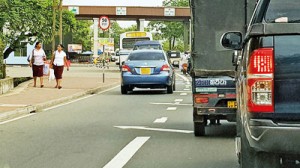Bus priority lanes cause chaos in Colombo
The on-going economic activities concentrated in the densely populated city of Colombo are attracting more people from the suburbs to the central business district. As a result, Colombo and its suburbs are forever congested during peak times due to the high vehicle volumes on an already overcrowded road network.

Cars on the bus lane during restricted hours
As an attempt to decongest and ease the traffic flows, the current government is investing Rs. 400 million in bus priority lanes (BPL) to speed up vehicular traffic.
Such lanes are generally restricted to buses; however, in Colombo these lanes are also to be accessible to high occupancy vehicles such as school and other transport vans, which shouldn’t be the case.
Supposedly, the BPL proposal is in full swing, despite it being based on a very rudimentary pilot study conducted in early 2017 that surveyed a 1 km stretch in Rajagiriya—this being contrary to an international expert’s recommendation to evaluate at least a 3-4 km stretch in order to come to an informed conclusion. Despite a cabinet paper on ‘Improving bus service to promote public transport’ stating the requirement for a detailed feasibility analysis before implementation, no such report has been presented. However, upon investigating, these key phases of the project have allegedly obtained the necessary approval through substandard analytical methods, compared to recognised standard methods. It is a crime to spend Rs.400 million of the public funds on this basis.
Studies that have been carried out on the Rajagiriya route reveal that the BPL has failed miserably, adding approximately an additional 10 minutes to morning peak travel time. Without the BPL, traffic was flowing at 10 km/hr (which is by no means a good pace); however, with the introduction of the BPL, the average speed of traffic flow had subsequently slowed to almost to 5 -7 km/hr. Galle Road BPL showed promising results until peak time traffic hit the roads, at which point there were additional delays to journey times. Each section of the bus lane caused chaos to the expected flow of traffic. Deceptively, the project emphasises an increase in average speed times up to 21 km/hr; but fails to mention this is during school holiday times, where traffic flow is considerably less and peak time speeds are considerably lower than the average speed.
During the pilot study period and during the implementation of the project, average vehicular speeds were consistently less compared to no BPL. The economic loss of implementing the BPL has been estimated to be running into hundreds of millions of rupees per week.
An expert is not required in order to work out why this has failed. It was faster for passengers to walk when a BPL was in operation. The fundamental assumption of shifting passengers from private vehicles to public transport did not materialise as envisaged.
Contributory factors for this are that buses are already over-crowded and basic and the limited wellbeing of bus passengers, etc. Not to mention the lack of concern for road rules for which Sri Lankan motorists are renowned, including the using the BPL as their own high-speed lane.
It is ironic that the very solution (BPL) to ease congestion and improve traffic flow has exacerbated the very problem it was supposed to resolve. There is no shortage of reports suggesting the success of BPL; however, these are not compiled independently. They stem from the same source that recommended and implemented the project.
Despite the gloomy outlook for the BPL, as well as the overwhelming amount of evidence contradicting its supposed benefits, the project is still pursued by a few influential people in their attempts to appease politicos and other influential people who have a personal interest in the project.
There are big plans for the Colombo bus transport system, the ultimate intention being to implement an integrated bus network (known as Bus Rapid Transit BRT) with dedicated bus stations, a payment mechanism, and better facilities for passengers, etc. More importantly, the BPL is a critical component for the project to succeed. The question remains as to how, if a BPL cannot endure, a fully-fledged Bus Rapid Transit system can be sustained?
Any person can criticise, condemn, and complain without proposing a solution to the superseding issues of congestion and traffic in Colombo. However, the authorities should not test superficial theories without any process of due diligence at the cost of tax payers. Unfortunately for the country, successive governments have failed to understand this.


